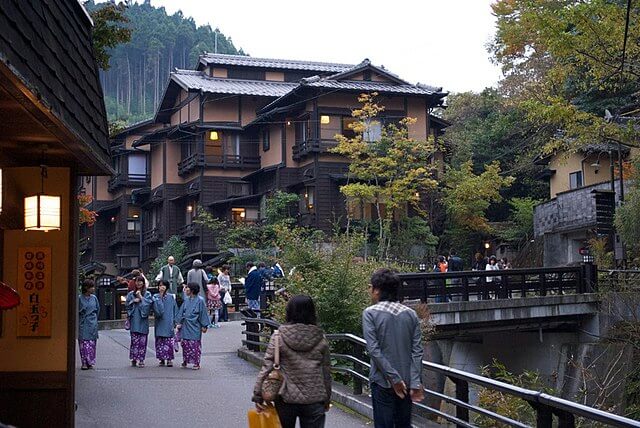Located deep in the south of Japan, Kumamoto (heck, Kyushu as a whole) doesn’t get enough love. It’s a shame, because that part of the country has a lot to offer from unique castle architecture to gorgeous outdoor destinations like Yakushima. And let’s not forget that there are some incredible onsen, too.
With that in mind, here are the 6 best onsens in Kumamoto:
Get ready to pack your bags and do some onsen hopping, because Kumamoto has luxurious baths in spades.
Wanna learn more about bathing in Japan? See the funny side in the Bath House Rules, a Forever Foreign essay.
1. Kurokawa Onsen
Number one on this list is the onsen that Kumamoto is probably most famous for: Kurokawa onsen.
Located in the heart of Kumamoto prefecture, this charming town is filled with ryokans (traditional Japanese inns) and public baths where visitors can soak in the hot springs.

Spending the night and enjoying a ryokan is the best way to enjoy Kurokawa Onsen, but even if you only pass through, you’ll still leave feeling like you warped to a simpler time in Japan.
The atmosphere is as relaxing as it gets, making it a popular destination for those looking to escape the hustle and bustle of city life. Show up from December to April and you can get a little more magic as the place is lit up with bamboo lanterns for the Yu Akari festival.
Unique Qualities of Kurokawa Onsen
- Traditional onsen village
- Yu Akari festival
- Plenty of ryokans and public baths
Kurokawa Onsen Access
Day-use ranges from ¥5-800 per person, and each onsen has a slightly different schedule for day use (the circles indicate days of the week where day use is allowed).
While the best way to get there is by rented car, you can also use public transit and a reserved coach bus:
- From Fukuoka: Take a train from Hakata Station to Aso Station, then transfer to a reserved coach bus to Kurokawa Onsen.
- From Kumamoto: Take a train from Kumamoto Station to Aso Station, then transfer to a coach bus to Kurokawa Onsen.
2. Shimoda Onsen
Smaller islands around Japan just have a different feel to them. Populations are lower, tourists are less likely to be poking around, and the reward is often a dreamlike experience among rolling hills and sprawling coastline.

That’s what you get with Shimoda onsen. And if there were ever a place to book a room at a ryokan, this would be it. It’ll give you the time you need to properly soak up the tranquility that you can only find at an island onsen.
You can get to this Kumamoto onsen by bus, but renting a car may make things a little simpler.
Unique Characteristics of Shimoda Onsen
- Onsen right on the coast
- Located in the hills
- Breathtaking outdoor baths with sunsets

Image by Kohji Asakawa
Shimoda Onsen Access
Day-use starts at ¥700 per person. We recommend a car to get there, but you also have these choices:
- From Fukuoka: Take a train from Hakata Station to Kumamoto Station, then transfer to a reserved seat on the Amakusa-go bus bound for Shimoda Onsen.
- From Kumamoto: Take the same bus straight from Kumamoto Station to Shimoda Onsen.
3. Tamana Onsen
Northwest of Kumamoto City is the coastal town of Tamana. Famous for their Senryu ramen, they also happen to have an incredible onsen scene.
It’s a popular destination among those seeking a serene, rejuvenating experience, and also happens to be a fairly easy trek from Kumamoto city.
If you make the trek over, you can expect clear, alkaline waters that leave your skin silky smooth.
Unique Characteristics of Tamana Onsen
- Beautiful scenery and quiet atmosphere
- Secluded countryside locale
- Alkaline water

Photo by Xie lipton
Tamana Onsen Access
Day-use starts at ¥400 per person. Public transport options are as follows:
- From Fukuoka: Take a train from Hakata Station to Tamana Station, then transfer to a local bus to Tamana Onsen.
- From Kumamoto: Take a train from Kumamoto Station to Tamana Station, then transfer to a local bus to Tamana Onsen.
4. Ueki Onsen
A little to the east of Tamana is Ueki Onsen, a hidden gem located in the rural area north of Kumamoto City.
This onsen is known for its rustic charm and natural beauty, making it a perfect destination for those looking for a peaceful, rejuvenating experience.
As with most popular hot springs and spas, Ueki onsen has a host of classic ryokans to choose from. It also boasts alkaline water that may have natural healing properties for your skin.
One more reason to go there is that it’s not too far from Kumamoto city, making it a great option for those looking for something more convenient.
Unique Characteristics of Ueki Onsen
- Rustic charm and natural beauty
- Secluded and peaceful atmosphere
- Different qualities at each onsen as each water source is different
Ueki Onsen Access
Day-use starts at ¥500 per person and reaches as high as ¥2,000.
You can access the area with the following options:
- From Fukuoka: Take a bus from Hakata Station to Ueki station, then a local bus to your preferred onsen.
- From Kumamoto: Take a train from Kumamoto Station to Hitoyoshi Station, then transfer to a local bus to Ueki Onsen. OR, simply take a bus all the way from Kumamoto.
5. Yamaga Onsen
Go a little north of Ueki Onsen and you’ll end up in Yamaga City, a town full of lovely onsen. This area has supposedly been popular for its hot springs for more than 1,300 years, so it’s got a lot of reviews to back it up.
Among the storied onsen is Sakurayu, a bathhouse that was built with Edo-period wooden architecture and unfortunately demolished in the 1970s.

Image by Kohji Asakawa
Thankfully, it was re-built in 2012 and makes a great stop for those looking for an edo-period bathhouse aesthetic.
Unique Characteristics of Yamaga Onsen
- Luxury options
- Massage access
- Edo-period aesthetics
Yamaga Onsen Access
Day-use of this area’s onsen starts as low as ¥400 per person. To get there, choose one of the following options:
- From Fukuoka: Take a bus from Hakata Station to Yamaga Onsen with a local transfer in Ueki.
- From Kumamoto: Take a local bus from Kumamoto Station to Yamaga Onsen.
6. Hitoyoshi Onsen
If you’re into history, Hitoyoshi City is another place full of onsen to check off the list.
Located in the south of Kumamoto prefecture, Hitoyoshi Onsen is known as a culturally significant location since the hot spring waters were frequented by the local daimyo during the warring states period (more than 500 years ago).

Image by Kohji Asakawa
Because of that and the fact that Hitoyoshi City is a town with castle ruins, its onsens are popular destinations among history buffs.
They’re not only for academics, though! This south-Kumamoto onsen paradise also happens to have some fantastic ryokan options like the most famous one in the area that was started in 1910.
Unique Characteristics of Hitoyoshi Onsen
- Rich history and cultural significance
- Traditional atmosphere
- Alkaline water with slight carbonation
Hitoyoshi Onsen Access
Day-use from ¥600-2,000 per person.
When making your way down to Hitoyoshi, public transportation options make things easy:
- From Fukuoka: Take a train from Hakata Station to Hitoyoshi Station, then transfer to a local bus bound for Hitoyoshi Onsen.
- From Kumamoto: Take a train from Kumamoto Station to Hitoyoshi Station, then transfer to a local bus to Hitoyoshi Onsen.
Does Kumamoto Have Good Onsen?
The answer is a resounding yes! Kumamoto is blessed with abundant geothermal sources, allowing it to display a wide range of onsen experiences for visitors. From traditional, serene onsens to modern, luxurious spas, there’s something for everyone in Kumamoto.
Conclusion
Whether you’re looking for something traditional and touristy, something quiet and secluded, or something modern and convenient, Kumamoto has an onsen for you.
Kyushu is worth a visit for an onsen tour alone, and Kumamoto is an incredible place to start.
Kurokawa onsen photo by hiroooooki from Tokyo, Japan – 黒川・湯布院温泉032, CC BY 2.0, https://commons.wikimedia.org/w/index.php?curid=15027269
Foot bath picture by STA3816 – Own work, CC BY-SA 4.0, https://commons.wikimedia.org/w/index.php?curid=75053787




